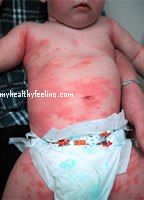Anaphylaxis symptoms is something that you need to be aware of, if you or your loved suffers from severe allergy. Anaphylaxis, also known as anaphylactic shock or anaphylactic allergic reaction, refers to severe allergic reaction that can be dangerous and even fatal. This happens after the person is exposed to the allergen he/she is allergic to. Anaphylaxis generally occurs suddenly, within minutes or even seconds after exposure to the allergen. There are instances, though, that the reaction is delayed. As soon as the symptoms show, you must seek medical attention.
Anaphylaxis symptoms
Anaphylaxis symptoms differ from one person to the other. While some people may experience life-threatening reactions, others, on the other hand may just feel certain discomforts in their body. The following are some of the symptoms of an anaphylactic reaction.
Life-threatening reactions that can lead to death:
Life-threatening reactions that can lead to death:
1. Difficulty breathing: Breathing difficulty is caused by the swelling or spasm in the airways, including the tongue. In some very serious cases, breathing comes to a halt.
2. Loss of consciousness: When the body goes into shock, the blood pressure becomes dangerously low, thus, resulting to loss of consciousness.
3. The heart stops pumping: This happens in very severe anaphylactic reactions.
Less severe symptoms that may cause discomfort:
1. Most anaphylaxis involves the skin. The following may be observed during a reaction.
o Erythema or redness
o Welts, hives or wheals. Hives are accompanied by severe itching.
o Inflammation or swelling of any of the following: ears, face, lips, eyelids, tongue, throat, feet and hands.
2. Breathing may also be affected due to the swelling of the tissues in the airways.
o Wheezing, tightness in the chest, difficult breathing
o Hoarseness, coughing
o Constant sneezing, nasal congestion
3. Cardiovascular symptoms
o Faintness, giddiness
o Irregular or fast heartbeat
o Collapse or loss of consciousness
4. Overall reaction of the body
o Usually, one of the first symptoms is a tingling or warm sensation.
o Difficulty swallowing
o Vomiting and nausea
o Stomach cramps, bloating, diarrhea
o Confusion
o Dread, anxiety; a general feeling that something bad is going to happen or you are going to die.
o Confusion
Anaphylaxis pictures
What to do if anaphylactic reaction occurs
Anaphylaxis is a medical emergency and should be treated as such in the hospital by qualified health care providers. If you experience trouble in breathing, feeling dizzy or light-headed, or show swelling in the mouth, tongue or throat, you should have yourself transported to the hospital immediately. While awaiting ambulance or transport to the hospital, you should self-treat. People with serious allergies should have epinephrine with them at all times. These are self-injectors prescribed by doctors to be used for anaphylactic attacks. A medical-alert bracelet will also aid medical personnel in giving you the appropriate treatment more quickly since this bracelet lets them know that you have severe allergy.
Anaphylactic allergic reaction can be quite frightening, dangerous and even fatal . Thus, knowing the various anaphylaxis symptoms will help you take the necessary action right away as soon as the symptoms start to show. The right treatment delivered on time can mean the difference between life and death.

